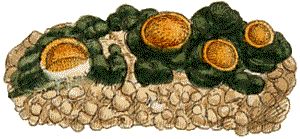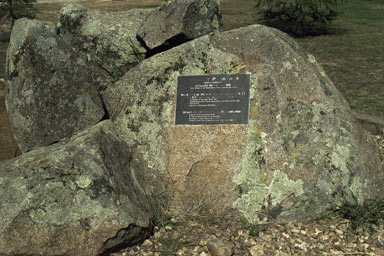 Ecology
Ecology
Pollution and lichens
Pollutants come in many forms in both town and country. Sulphur dioxide has been a significant industrial pollutant for many years, being a by-product of the use of high sulphur fuels. While sulphur-removal technology has reduced the level of sulphur dioxide pollution in many countries, it is still a significant pollutant in many areas. Smelters produce heavy metal pollutants and car exhausts contain nitrogen oxides. With the increase in intensive animal rearing ammonia is becoming a significant rural pollutant and agricultural chemicals such as fertilizers and herbicides make their way into soil and waterways. Oil spills are occasional pollutants of coastal areas. All of the above can have detrimental effects on lichens, though susceptibility to any particular pollutant need not be uniform across all lichen species. Pollutants may occur as microscopic particles, gases or liquids. Micro-granules of particulate pollutants may be absorbed by a growing thallus and, once embedded in thallus tissue, may leach out damaging chemicals over a long period. When it comes to pollutants and lichens, sulphur dioxide is the most intensively studied pollutant. This compound is a gas that dissolves readily in water to produce highly reactive acidic ions, which are readily absorbed through lichen thalli and, once absorbed, disrupt photosynthesis. Sulphur dioxide can also inhibit lichen reproduction (both sexual and asexual) as well as spore germination, though the effects are not uniform across species. Sulphur dioxide has also been shown to inhibit the activity of nitrogenase, which is used by cyanobacterial photobionts to fix atmospheric nitrogen![]() .
.
Some early observations
Observations about the paucity of lichens in urban areas go back to the mid 19th century. For example, the Manchester botanist Leo Grindon recorded many lichen species in his 1859 book about the flora of the city and the surrounding area but he noted that:
...the majority of those enumerated are not obtainable nearer [to Manchester] than on the high hills...and even there the quantity has been much lessened of late years, through the cutting down of old woods, and the influx of factory smoke, which appears to be singularly prejudicial to these lovers of pure atmosphere
.
In 1866 William Nylander published observations about the lichens in Paris, particularly those of the Jardin du Luxembourg, a large public park. He noted that in general lichens didn't seem to like cities and that urban lichens often showed incomplete development. According to Nylander lichens could give a good indication of the quality of the air and so constituted a very sensitive "health meter" for the surrounding air. Based on his observations about the numbers of lichen species (and numbers of thalli) found in various parts of Paris he concluded that Paris' healthiest area was to be found within the Jardin du Luxembourg. The richness in lichen species and quantity within parts of that park was such that, had you wished to see anything comparable, it would have been be necessary to look outside the city, in the cleaner country air![]() .
.
The next few decades saw published observations about the paucity of lichens in other European cities and the disappearance of species from areas where they had once been common. The first systematic mapping of a city's lichens was undertaken by the plant ecologist Rutger Sernander in Stockholm and its surrounds in the early 20th century. Sernander concentrated on epiphytic lichens and differentiated a central lichen desert, a surrounding struggle zone and, outermost, the normal zone. By 1934 detailed maps had been prepared for Oslo and Helsinki as well and since then similar maps or studies have been produced for many other cities. Sernander's concepts of desert, struggle and normal zones have been found to hold generally, though sometimes people have felt it necessary to introduce finer subdivisions into Sernander's broad categories.
Not just distance
While lichen diversity generally decreases the closer one moves to a city, there's more than distance involved when it comes to influencing lichen diversity. Several studies have shown that in sheltered sites various lichen species can survive and grow well in areas otherwise hostile to those same species. Trees, shrubbery and walls are examples of objects that can provide the necessary shelter and so provide suitable MICROHABITATS. For example patches of bare soil amongst a cluster of shrubs may support soil lichens that would not be found in such a site on exposed soil. In the 1960s and 1970s studies in several parts of England found the most diverse lichen assemblages to be in valleys or ravines, especially if there was good tree growth in those lower areas. The strongly polar sulphur dioxide molecules are readily deposited onto surfaces of all kinds. So, going back to the shrub example, the shrubs would intercept the great majority of the sulphur dioxide molecules thereby "scrubbing" the incoming air and so giving the nearby soil cleaner air. Wind-blown pollutants also have greater effects on higher, exposed areas such as hilltops than in valleys or ravines. An alkaline substrate can support lichens well into the struggle or desert zones, such a substrate acting as a buffer against acidic pollutants. A study of London's lichens, published in 1967, reported that 66% of the lichens found occurred on alkaline substrates. At roughly the same time in Newcastle upon Tyne concrete and asbestos were well-colonized at pollution levels that had cleared lichens from most other substrates. Studies in the 1960s also showed that in many urban areas epiphytic lichens persisted best on trees with alkaline bark.
Lecanora conizaeoides
Though sulphur dioxide is very damaging to many lichens some are highly tolerant. In the 19th century when coal was a common fuel the resulting smoke was rich in sulphur dioxide and lichen 'deserts' were typical around industrial centres, with very few species (or even none) to be found in such areas. The crustose lichen Lecanora conizaeoides tolerates high sulphur dioxide concentrations and during the later 19th and early 20th centuries was common in or near many of the major industrial cities of Europe. The later 20th century saw the reduction of coal fires as well as the implementation and enforcement of various clean air policies, all of which has led to a great decrease in sulphur dioxide levels in various cities. Such actions have led to an increase in the number of lichen species found in previously polluted urban centres, though in some cases the lichen 're-invasion' has been limited to nitrogen-tolerant species because of the high levels of nitrate or ammonium deposition. Another consequence of reduced sulphur dioxide levels has been the decline in abundance of Lecanora conizaeoides, since various other species easily out-compete it. During the many decades of higher levels of sulphur dioxide the competing species were kept at bay but now the once common Lecanora conizaeoides has become very rare in parts of Europe. Presumably this lichen is now present in levels closer to its levels before the industrial revolution. Lecanora conizaeoides grows naturally on acidic substrates, making it an acidophile. During the 19th and early 20th centuries the higher sulphur dioxide concentrations will have artificially acidified substrates that, otherwise, would not have hosted this lichen.
Oxidants
Sulphur dioxide emissions in southern California are very low but oxidants can be present in high concentrations. Various strongly oxidising compounds are produced photochemically when sunlight acts on compounds emitted in vehicle exhausts and possibly the best known such oxidant is ozone. Studies in southern California have shown that a number of lichens, common there in the early 20th century, have not been found there in recent years. Though there have been relatively few studies into the effects of strong oxidising compounds on lichens, several experimental studies have shown that ozone can be detrimental to lichens but, as with other pollutants, some species are more resilient than others.
|
Lichens and metals
Many people will have seen the damaging effects that some metals can have on lichens. Throughout the world there are numerous commemorative metal plaques fixed to boulders that have been placed in sites exposed to the weather. Such plaques are often of bronze, an alloy of copper, and copper forms the basis of several fungicides. The boulders, covered with lichens, may have been plucked from the wild and had plaques attached. Or, the boulders may have been extracted from beneath the earth and still been bare when the plaques were affixed. Once affixed the plaques are washed by rain. Compounds toxic to lichens leach out and are carried down the boulder in the runoff. Many existing lichens in the flow path are killed or, if the boulder started bare, many lichens are inhibited from growing in the flow path. After some time it is common to see a lichen desert below a plaque but with good lichen growth in areas not reached by the runoff. You can see this in the accompanying photograph. The dominant greenish lichens on the boulder belong to the genus Xanthoparmelia. Another example is shown by this photo ![]() of a handrail at the intersection if a footpath and a road. The handrail has been there for over a decade. A curved bare band on the footpath parallels the curved handrail because water has dripped from the handrail and deposited lichen-inhibiting zinc leachates onto the footpath below. In the enlarged view of part of the footpath you can see many brownish lichen thalli, with some colonising the margins of the drip zone.
of a handrail at the intersection if a footpath and a road. The handrail has been there for over a decade. A curved bare band on the footpath parallels the curved handrail because water has dripped from the handrail and deposited lichen-inhibiting zinc leachates onto the footpath below. In the enlarged view of part of the footpath you can see many brownish lichen thalli, with some colonising the margins of the drip zone.
![An Australian Government Initiative [logo]](/images/austgovt_brown_90px.gif)


